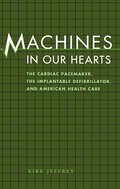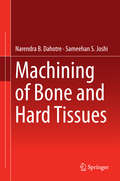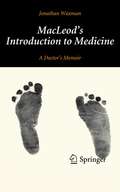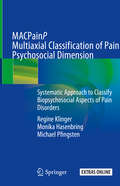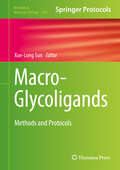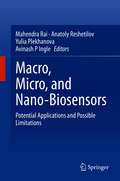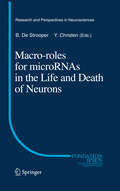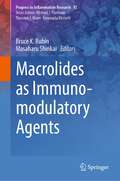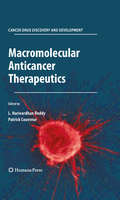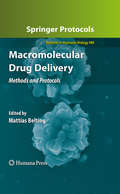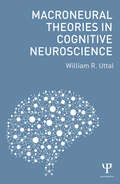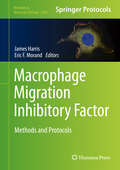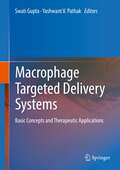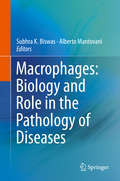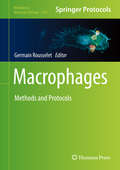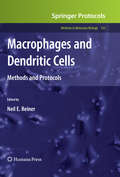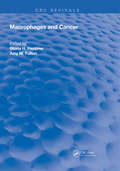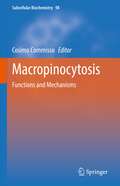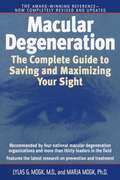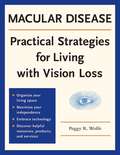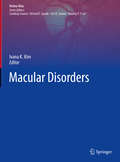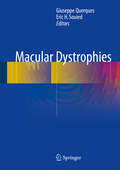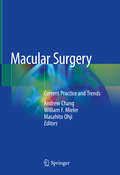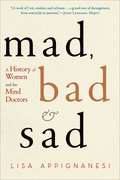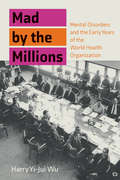- Table View
- List View
Machines in Our Hearts: The Cardiac Pacemaker, the Implantable Defibrillator, and American Health Care
by Kirk JeffreyToday hundreds of thousands of Americans carry pacemakers and implantable cardioverter-defibrillators (ICDs) within their bodies. These battery-powered machines—small computers, in fact—deliver electricity to the heart to correct dangerous disorders of the heartbeat. But few doctors, patients, or scholars know the history of these devices or how "heart-rhythm management" evolved into a multi-billion-dollar manufacturing and service industry. Machines in Our Hearts tells the story of these two implantable medical devices. Kirk Jeffrey, a historian of science and technology, traces the development of knowledge about the human heartbeat and follows surgeons, cardiologists, and engineers as they invent and test a variety of electronic devices. Numerous small manufacturing firms jumped into pacemaker production but eventually fell by the wayside, leaving only three American companies in the business today. Jeffrey profiles pioneering heart surgeons, inventors from the realms of engineering and medical research, and business leaders who built heart-rhythm management into an industry with thousands of employees and annual revenues in the hundreds of millions. As Jeffrey shows, the pacemaker (first implanted in 1958) and the ICD (1980) embody a paradox of high-tech health care: these technologies are effective and reliable but add billions to the nation's medical bill because of the huge growth in the number of patients who depend on implanted devices to manage their heartbeats.
Machining of Bone and Hard Tissues
by Narendra Dahotre Sameehan JoshiThis book provides an in-depth review of state-of-the-art orthopaedic techniques and basic mechanical operations (drilling, boring, cutting, grinding/milling) involved in present day orthopaedic surgery. Casting a light on exploratory hybrid operations, as well as non-conventional techniques such as laser assisted operations, this book further extends the discussion to include physical aspects of the surgery in view of material (bone) and process parameters. Featuring detailed discussion of the computational modeling of forces (mechanical and thermal) involved in surgical procedures for the planning and optimization of the process/procedure and system development, this book lays the foundations for efforts towards the future development of improved orthopaedic surgery. With topics including the role of bone machining during surgical operations; the physical properties of the bone which influence the response to any machining operation, and robotic automation, this book will be a valuable and comprehensive literature source for years to come.
MacLeod's Introduction to Medicine: A Doctor’s Memoir
by Jonathan Waxman'MacLeod's Introduction to Medicine: A Doctor's Memoir' is a collection of stories that gives the reader an insight into the humorous side of a doctor's life. There is a rich source of humor in medicine, and this book aims to share some of this.
MACPainP Multiaxial Classification of Pain Psychosocial Dimension: Systematic Approach to Classify Biopsychosocial Aspects of Pain Disorders
by Regine Klinger Monika Hasenbring Michael PfingstenThis book offers a diagnostic tool for physicians and psychologists who want to systematically document pain within a multimodal structure. MACPainP (multiaxial classification of pain-psychosocial dimension) is a systematic, comprehensive and clinically oriented diagnostic instrument for evaluating pain-related disorders, and includes differentiated descriptions to enable syndromes to be systematized and diagnoses compared. MACPainP can be used as a professional add-on for the International Classification of Diseases ICD-10 as well as the upcoming pain classification ICD-11, released by WHO. This clearly structured book provides an easy introduction to the biopsychological aspects of pain disorders, to allow a nuanced approach to the psychological diagnosis of pain patients. It discusses possible comorbidities (e.g. depressive disorders, anxiety disorders) as well as concrete behavior-related steps for pain-related psychological and medical treatments. An essential reference for physicians and psychologists in the field of pain therapy, it is part of the learning European Pain Federation Curriculum (EFIC) of pain therapists.
Macro-Glycoligands
by Xue-Long SunThis volume details methods and protocols for the synthesis and characterization of glycopolymers and their biomedical applications. Chapters are divided into three parts covering synthesis and characterization of glycopolymers; glycopolymer-nanoparticle conjugates; and surface immobilized glycopolymers. Written for the Methods in Molecular Biology series, chapters include introductions to their respective topics, lists of the necessary materials and reagents, step-by-step, readily reproducible laboratory protocols, and tips on troubleshooting and avoiding known pitfalls. Authoritative and practical, Macro-Glycoligands: Methods and Protocols aims to ensure successful results in the further study of this vital field.
Macro, Micro, and Nano-Biosensors: Potential Applications and Possible Limitations
by Mahendra Rai Anatoly Reshetilov Yulia Plekhanova Avinash P. IngleThis book includes an international group of researchers who present the latest achievements in the field of enzyme, immune system, and microbial and nano-biosensors. It highlights the experimental evidence for formation of biological fuel cells (BFCs)-which has a dual purpose – as a device that produces electricity and the systems which produce it simultaneously cleaning up the environment from polluting organic compounds. Considering the work in the field of macro, micro and nano-biosensors, considerable attention is paid to the use of nanomaterials for the modification of working electrodes. Nanomaterials in some cases can significantly improve the parameters of analytical systems. Readers will be interested in the projection of the presented theoretical and experimental materials in the field of practical application of modern analytical developments. The presented results in many cases imply the possibility of using the created models of macro, micro and nano-biosensors, and biofuel elements in the field of health, and protection/restoration of the environment. It includes information about all existing types of transducers of signals in biosensors – electrochemical, optical and quantum-optics, thermoelectric, data of atomic force microscopy, piezoelectric, and more. On the basis of these principles, descriptions are given about the functioning of macro, micro and nano- biosensors for the detection of compounds used in medicine, detection of compounds that clog the environment, and thus affect human health, for compounds that are potentially the basis for the production of drugs, for the selection of compounds that have medicinal activity, for immunodetection, and to assess the quality of food. These questions form the basis of research carried out in the field of biosensors in the world. Since the described models of biosensors have high sensitivity, high measurement speed and selectivity, the described results attract the attention of both the ordinary reader and business class specialists who create and implement analytical technologies. This book is very useful for researchers in life sciences, chemical sciences, physics, and engineering. In addition, it will be useful for the persons working in industry. Advanced technologies specialists will be attracted by the novelty of the proposed solutions and their relevance and ease of implementation. Since the studies contain sections describing the parameters of different biosensors, BFCs, they are easily navigated into assessing the effectiveness of the practical use of the proposed device. The relevant sections indicate such characteristics as detection ranges, life span, type of biological material used, the method of formation of the bio-receptor part. These parameters are of interest to both developers of new models of biosensors and BFC, and their manufacturers.
Macro Roles for MicroRNAs in the Life and Death of Neurons
by Bart De StrooperThe discovery of microRNAs has revealed an unexpected and spectacular additional level of fine tuning of the genome and how genes are used again and again in different combinations to generate the complexity that underlies for instance the brain. Since the initial studies performed in C.elegans, we gave gone a far way to begin to understand how microRNA pathways can have an impact on health and disease in human. Although microRNAs are abundantly expressed in the brain, relatively little is known about the multiple functions of these RNA molecules in the nervous system. Nevertheless, we know already that microRNA pathways play major roles in the proliferation, differentiation, function and maintenance of neuronal cells. Several intriguing studies have linked microRNAs as major regulators of the neuronal phenotype, and have implicated specific microRNAs in the regulation of synapse formation and plasticity. Dysfunction of microRNA pathways is also slowly emerging as a potential important contributor to the pathogenesis of major neurodegenerative disorders such as Alzheimer's disease and Parkinson's disease. These novel insights appear to be particular promising for the understanding of the very frequent and badly understood sporadic forms of these diseases as compared to the genetic forms. Thus, the better understanding of the implications of this novel field of molecular biology is crucial for the broad area of neurosciences, from the fundamental aspects to the clinic, and from novel diagnostic to potentially therapeutic applications for severe neurological and maybe psychiatric diseases.
Macrolides as Immunomodulatory Agents (Progress in Inflammation Research #92)
by Bruce K. Rubin Masaharu ShinkaiFor over 50 years, clinicians have known that macrolide antibiotics have effects on inflammation and the immune system that are not related to their antimicrobial properties. These immunomodulatory properties, best described for treating inflammatory airway diseases, protect the lung and the host and improve clinical status. This book summarizes our current knowledge regarding proposed mechanisms for these properties, established clinical results, and what the future may hold with emphasis on novel clinical applications and the fascinating development of non-antimicrobial macrolides with preserved and enhanced immunomodulatory properties.
Macromolecular Anticancer Therapeutics
by Patrick Couvreur L. Harivardhan ReddyIn spite of the development of various anticancer drugs, the therapy of cancer has remained challenging for decades. The current therapy of cancer is overwhelmed because of the inability to deliver therapeutics to all regions of a tumor in effective therapeutic concentrations, intrinsic or acquired resistance to the treatment with currently available agents via genetic and epigenetic mechanisms, and toxicity. As a result, cancer therapy using conventional therapeutics and different types of treatment regimens using this therapeutics has not led to a convincing survival benefit of the patients. In this context, Macromolecular therapeutics offer several advantages over conventional low molecular therapeutics by various ways such as, enable the use of larger doses of these agents by limiting the toxicity, by enhanced permeability and retention into tumors, by tumor targeting using tumor-specific antibodies, by specific inhibition of oncogenes using anticancer oligonucleotides etc. Cancer treatment using this macromolecular therapeutics has considerably improved the survival benefit for patients. As a result, various macromolecular therapeutics are already commercialized or are under clinical development. Although we are far from a real magic bullet today, looking at the pace of research and current success in this field of macromolecular therapeutics, it appears that we are approaching a magic bullet for the efficient treatment of cancer. Thus, we believe that the subject of this book is very timely, and that the book will fill an unmet need in the market. This book is unique and assembles various types and aspects of macromolecular anticancer therapeutics for cancer therapy in one shell and conveys the importance of this interdisciplinary field to the broad audience. Thus, in a nutshell, this book details the basics of cancer, and various therapeutic strategies such as those based on macromolecular therapeutics hence can become an important reference for practitioners, oncologists, medical pharmacologists, medicinal chemists, biomedical scientists, experimental pharmacologists, pharmaceutical technologists, and particularly it can essentially become a handbook of macromolecular therapeutics for cancer therapy for graduates, post-graduates and Ph.D. students in these fields.
Macromolecular Drug Delivery
by Mattias BeltingMacromolecular drugs hold the promise of becoming new therapeutics for several major disorders, including cancer and cardiovascular disease. This incredible potential is explored in Macromolecular Drug Delivery, a volume which gives a wide-ranging overview of contemporary methods used in the field, and which addresses the limitations presented by a lack of safe and efficient drug delivery strategies. Chapters offer information on both in vitro and in vivo methods of macromolecular delivery, thus appealing to a broad scientific audience. Composed in the highly successful Methods in Molecular BiologyTM series format, each chapter contains a brief introduction, step-by-step methods, a list of necessary materials, and a Notes section which shares tips on troubleshooting and avoiding known pitfalls. Comprehensive and cutting-edge, Macromolecular Drug Delivery offers a platform for interdisciplinary collaboration, which should provide opportunities for new discoveries at the interface between disciplines. Ultimately, this cooperation will lead to the use of macromolecular drugs as novel diagnostic tools and, even more importantly, as a means to revolutionize the way we view and treat diseases.
Macroneural Theories in Cognitive Neuroscience
by William R. UttalIn this book, William R. Uttal continues his analysis and critique of theories of mind. This book considers theories that are based on macroneural responses (such as those obtained from fMRI) that represent the averaged or cumulative responses of many neurons. The analysis is carried out with special emphasis on the logical and conceptual difficulties in developing a theory but with special attention to some of the current attempts to go from these cumulative responses to explanations of the grand question of how the mind is generated by the brain. While acknowledging the importance of these macroneural techniques in the study of the anatomy and physiology of the brain, Uttal concludes that this macroneural approach is not likely to produce a valid neural theory of cognition because the critical information—the states of the individual neurons—involved in brain activity becoming mental activity is actually lost in the process of summation. Controversial topics are considered in detail including discussions of empirical, logical, and technological barriers to theory building in cognitive neuroscience.
Macrophage Migration Inhibitory Factor: Methods and Protocols (Methods in Molecular Biology #2080)
by James Harris Eric F. MorandThis volume looks at--and discusses the techniques of--a range of areas in biology in which macrophage migration inhibitory factor (MIF) is studied. Topics covered in this book include methods to quantify MIF in cell supernatants and human samples, using ELISA and western blot; detection and analysis of intracellular MIF using flow cytometry; genotyping of human MIF polymorphisms, detection of MIF expression in a marine invertebrate using rapid amplification of cDNA RACE; studying the MIF receptor CD74 in tissues using immunohistochemistry; and studying MIF in models of disease such as asthma, Plasmodium infection, and gout. Written in the highly successful Methods in Molecular Biology series format, chapters include introductions to their respective topics, lists of the necessary materials and reagents, step-by-step, readily reproducible laboratory protocols, and tips on troubleshooting and avoiding known pitfalls. Comprehensive and practical, Macrophage Migration Inhibitory Factor: Methods and Protocols is a valuable resource that will help researchers gain a new understanding of MIF biology in health and disease.
Macrophage Targeted Delivery Systems: Basic Concepts and Therapeutic Applications
by Yashwant V. Pathak Swati GuptaThe proposed book is envisioned for the nascent and entry-level researchers who are interested to work in the field of drug delivery and its applications specifically for macrophage targeting. Macrophages have gained substantial attention as therapeutic targets for drug delivery considering their major role in health and regulation of diseases. Macrophage-targeted therapeutics have now added significant value to the lives and quality of life of patients, without undue adverse effects in multiple disease settings. We anticipate examining and integrating the role of macrophages in the instigation and advancement of various diseases. The major focus of the book is on recent advancements in various targeting strategies using delivery systems or nanocarriers followed by application of these nanocarriers for the treatment of macrophage associated disorders. Macrophage Targeted Delivery Systems is primarily targeted to Pharmaceutical Industry & Academia, Medical & Pharmaceutical Professionals, Undergraduate & Post graduate students and Research Scholars, Ph.D, post docs working in the field of medical and pharmaceutical sciences.
Macrophages: Biology and Role in the Pathology of Diseases
by Subhra K. Biswas Alberto MantovaniMacrophages are a key component of the innate immune system and play an integral role in host defense and homeostasis. On one hand, these cells contribute to host defence by triggering inflammation, displaying microbicidal/tumoricidal properties, regulating the activation of adaptive immunity and promoting resolution of inflammation. On the other hand, they contribute to essential trophic functions such as neural patterning, bone morphogenesis and ductal branching in mammary glands. Thus, macrophages are extremely versatile cells that can respond efficiently to tissue micro environmental cues by polarizing to distinct phenotypes, depending on the functions they need to perform. Indeed, functional diversity and plasticity are hallmarks of these cells. Macrophages may also play a detrimental role. An overwhelming body of literature has indicated their crucial role in pathogenesis. The list includes sepsis, cancer, metabolic syndrome, immunodeficiency, auto-immune disease-virtually impacting every major pathology that we know. These observations have suggested macrophages and their related molecules as potential targets in therapeutic applications. Available evidence proclaims macrophages as a key player in homeostasis, host defense and disease. Crucial developments in the past few years call for a re-evaluation and update of our understanding of macrophages. The present book is an endeavour that attempts provide state-of-the art knowledge of these cells in health and disease.
Macrophages: Methods And Protocols (Methods in Molecular Biology #1784)
by Germain RousseletThis volume discusses basic and advanced techniques to study macrophages and their unique properties. The chapters in this book cover numerous topics such as in vitro culture models for murine and human macrophages; isolation of resident macrophages from several tissues; functional analyses of macrophages; and transgenic models of macrophage depletion and macrophage targeting. Written in the highly successful Methods in Molecular Biology series format, chapters include introductions to their respective topics, lists of the necessary materials and reagents, step-by-step, readily reproducible laboratory protocols, and tips on troubleshooting and avoiding known pitfalls.Cutting-edge and comprehensive, Macrophages: Methods and Protocols is a valuable resource for researchers who are interested in studying macrophages on an experimental level.The chapters A Simple Multi-Step Protocol for Differentiating Human Induced Pluripotent Stem Cells into Functional Macrophages and Isolation and Phenotyping of Adult Mouse Microglial Cells are open access under a CC BY 4.0 license via link.springer.com.
Macrophages and Dendritic Cells
by Neil E. ReinerIn light of the critical contributions of macrophages and dendritic cells to diverse inflammatory diseases and to immunity and host defense, state-of-the-art approaches to the investigation of their behavior are essential. In Macrophages and Dendritic Cells: Methods and Protocols, expert researchers contribute laboratory protocols involving these two vital cell types functioning at the junction of the innate and acquired immune systems. The volume delves first into isolation and cell culturing then continues with topics such as phagocytosis, genetic manipulation, macrophage activation, and lipid signaling. Written in the highly successful Methods in Molecular BiologyTM series format, chapters include brief introductions to their respective subjects, lists of the necessary materials and reagents, step-by-step, readily reproducible protocols, and notes on troubleshooting and avoiding known pitfalls. Authoritative and cutting-edge, Macrophages and Dendritic Cells: Methods and Protocols provides a timely and useful guide for both seasoned investigators and neophytes pursuing this imperative field of study.
Macrophages & Cancer (Routledge Revivals)
by Gloria H. Heppner Amy M. FultonFirst Published in 1988, this book offers a full, comprehensive guide into the relationship between macrophages and Cancer. Carefully compiled and filled with a vast repertoire of notes and references this book serves as a useful reference for Students of Medicine, Oncology and other practitioners in their respective fields.
Macropinocytosis: Functions and Mechanisms (Subcellular Biochemistry #98)
by Cosimo CommissoThis book presents the functions and mechanisms of macropinocytosis, an actin-driven endocytic uptake process.Key points, including the evolutionary origins of macropinocytosis and major signaling pathways that regulate this uptake mechanism, are highlighted. A wide-array of functions of macropinocytosis are described, including cellular metabolism, cell death, cell migration and antigen presentation. Macropinocytosis has recently been recognized as a critical pathway in disease pathology and treatment. Therefore, a broad overview of macropinocytosis will benefit clinicians, as well as translational and basic research scientists. Moreover, as one of the main clathrin-independent endocytic routes, compiling all the critical information about macropinocytosis in one collection, this book will also be helpful to educators and their students.
Macular Degeneration: The Complete Guide to Saving and Maximizing Your Sight
by Lylas G. Mogk Marja MogkDr. Lylas Mogk has a unique personal and professional understanding of AMD. This book explains how to successfully manage and limit its effect on a person's life.
Macular Disease: Practical Strategies for Living with Vision Loss
by Peggy R. WolfeThis invaluable guide to living well with vision loss is the perfect blend of abundant factual material and real-life experience. The book's positive, take-charge approach offers reassurance, hope, and hundreds of proven techniques, strategies, and tips for both the newly diagnosed and those at later stages of their disease. "My Story" vignettes in each chapter describe the author's fears, foibles, and triumphs in challenging situations. Readers will identify with the author's experiences and be encouraged by knowing she successfully traveled the same path.
Macular Disorders (Retina Atlas)
by Ivana K. KimThis atlas presents chapters on common and rare macular diseases including variants of age-related macular degeneration (dry, neovascular, polypoidal choroidal vasculopathy), cystoid macular edema, macular telangiectasia, central serous retinopathy and pachychoroid disease, photic retinopathy, presumed ocular histoplasmosis syndrome, myopic degeneration, angioid streaks, and a recently described entity: perifoveal exudative vascular anomalous complex. It provides a wealth of representative images, using various modalities to help the reader recognize the respective conditions. Importantly, it also includes images acquired using techniques more recently adopted in clinical practice such as autofluoresence, optical coherence tomography (OCT), and OCT angiography. The concise text reviews the basic concepts of etiology, diagnosis, and management in a highly accessible format. In contributions prepared by internationally respected experts, the atlas provides a cutting-edge analysis of each condition, as well as excellent summaries of recent work in the field. Macular Disorders is one of nine volumes in the series Retina Atlas. The series offers a global perspective on vitreoretinal diseases, covering imaging basics, retinal vascular disease, ocular inflammatory disease, retinal degeneration, surgical retina, macular disorders, ocular oncology, pediatric retina and trauma. In nine volumes and over 100 chapters, Retina Atlas offers comprehensive and validated information on retinal disorders.
Macular Dystrophies
by Giuseppe Querques Eric H. SouiedThis book provides the ophthalmologist with the most recently available data on the macular dystrophies, a group of many different inherited or sporadic eye conditions linked by a problem with photoreceptors or other structures of the central retina. Internationally recognized experts in the field present the latest evidence and discuss their own personal experiences with regard to each of the principal dystrophies as well as some very rare entities. Topics covered include molecular biology, state-of-the-art diagnostic techniques, and the newest treatment options, including still experimental therapies. Attention is also devoted to a range of issues that continue to be debated. The editors have taken care to ensure that chapters are of a uniformly high standard while not sacrificing the originality of the individual authors. Macular Dystrophies will fully acquaint the reader with both the latest research findings and the current and emerging approaches to diagnosis and treatment.
Macular Surgery: Current Practice and Trends
by Andrew Chang William F. Mieler Masahito OhjiRecent technological advances in the diagnosis of macular disorders have enhanced our understanding of these diseases. At the same time, advances in small-gauge vitrectomy instrumentation and techniques have improved the safety and efficiency of surgery, allowing macular conditions that would have otherwise resulted in blindness to be treated effectively, preserving patients’ sight. Macular surgery continues to evolve rapidly, thanks to exciting future technology trends. This book provides a detailed and up-to-date overview of the field. It begins with essential information on macular anatomy and pathophysiology, examination techniques, and surgical instrumentation. In turn, it discusses a broad range of disease processes, including macular holes, epiretinal membrane, vitreomacular traction and myopic maculopathy. The role and benefits of advanced vitrectomy techniques including submacular surgery, prosthetic vision, robotic surgery, and stem cell and gene therapy are addressed in detail. A review of perioperative care and potential complications rounds out the coverage.
Mad, Bad and Sad: A History of Women and the Mind Doctors
by Lisa AppignanesiThis fascinating history of mind doctors and their patients probes the ways in which madness, badness, and sadness have been understood over the last two centuries. Lisa Appignanesi charts a story from the days when the mad were considered possessed to our own century when the official psychiatric manual lists some 350 mental disorders. Women play a key role here, both as patients "among them Virginia Woolf, Sylvia Plath, and Marilyn Monroe" and as therapists. Controversially, Appignanesi argues that women have significantly changed the nature of mind-doctoring, but in the process they have also inadvertently highlighted new patterns of illness.
Mad by the Millions: Mental Disorders and the Early Years of the World Health Organization (Culture and Psychiatry)
by Harry Yi-Jui WuThe World Health Organization's post-World War II work on the epidemiology and classification of mental disorders and its vision of a "world psyche."In 1946, the World Health Organization undertook a project in social psychiatry that aimed to discover the epidemiology and classification of mental disorders. In Mad by the Millions, Harry Y-Jui Wu examines the WHO's ambitious project, arguing that it was shaped by the postwar faith in technology and expertise and the universalizing vision of a "world psyche." Wu shows that the WHO's idealized scientific internationalism laid the foundations of today's highly highly metricalized global mental health system.
